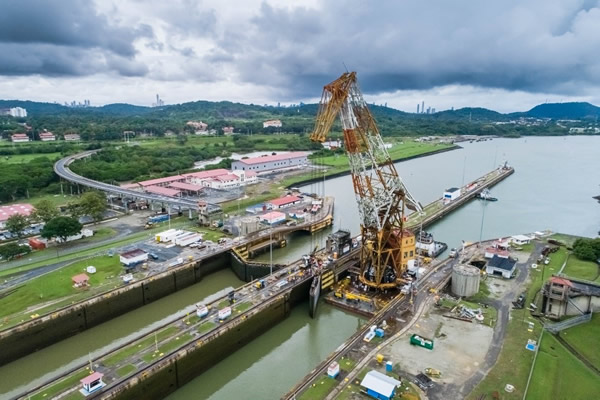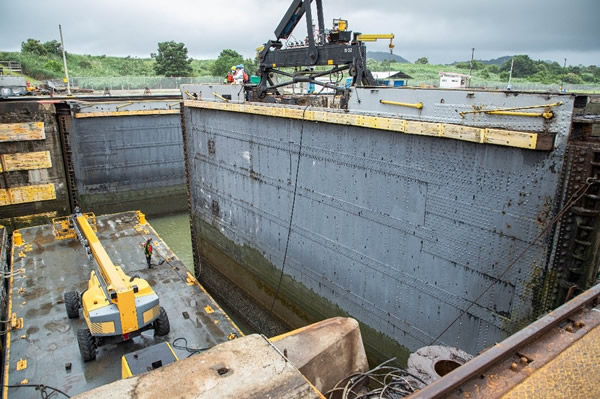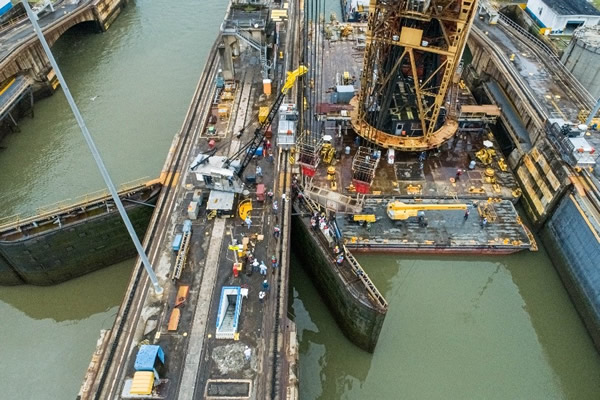106 years ago this month, the Panama Canal opened and reshaped world trade forever. Since then, the waterway has seen over a million vessels transit its locks, and come to serve 144 trade routes that connect 1,700 ports across 160 countries today.
The key to the Panama Canal’s continued, smooth operations over the past 106 years? A combination of its committed workforce and a rigorous maintenance program perfected over the past century and modernized with 21st century technology. Both were in full force this month as maintenance was carried out at the Panamax Locks across two days as part of the Panama Canal’s routine efforts to ensure a safe and reliable service.
Carefully Choreographed Maintenance, 100 Years in the Making, Completed on the Panama Canal Locks
To minimize the impact on transits, maintenance was performed simultaneously at the Miraflores and Pedro Miguel Locks between August 25 and 26. This required support from 120 workers and multiple divisions, including the Locks Division, Industrial Shipyards, Engineering and Dredging. While the West Lane of the Locks were closed during this period, transits continued on a regular basis through the Neopanamax Locks, as well as the East Lane of the Panamax Locks.

The floating crane, Titán, aiding maintenance efforts at the Miraflores Locks
At Miraflores, the work involved replacing yoke bushings and girders, which hold the gate when in regular operation. Given the gates at the Miraflores Locks weigh between 353.8 and 662.2 tons, the team brought in the floating Titán crane to lift the gate and then replace the bushings. The efforts took 34 hours to complete

A gate is lifted as part of routine maintenance at the Miraflores Locks
Meanwhile, tire fenders at the Pedro Miguel Locks were replaced, an endeavor that spanned 12 hours. Gerardo Ríos, infrastructure maintenance foreman for the Pedro Miguel Locks, explained that, “the two fenders help the vessel and the captain align the boat with the chamber. These tires rotate, protecting the infrastructure of the Canal as well as the vessel.”
A reminder of the Panama Canal’s modernization over the past 106 years, the waterway’s fenders were originally constructed with spring-loaded wood, though they have since been upgraded to rubber fenders with a vulcanized layer of very low friction Ultra High Molecular Weight Polyethylene. The fenders used today weigh 14,000 pounds each and are replaced as part of maintenance programs or when they show some level of wear as a result of their intended use.

Maintenance efforts underway at the Miraflores Locks
These efforts are just one of the over 100 maintenance projects that the Panama Canal performs annually. In fact, each year the Panama Canal invests roughly $200 million to sustain the waterway’s infrastructure and equipment, inspecting every structure at the waterway at least once, and analyzing all machinery, buildings, and lock components even more frequently.
With each project, the team plans, announces, and carefully choreographs its moves weeks in advance. This is all to ensure that the Panama Canal’s operations remain smooth and steady today, and for 106 more years to come.



